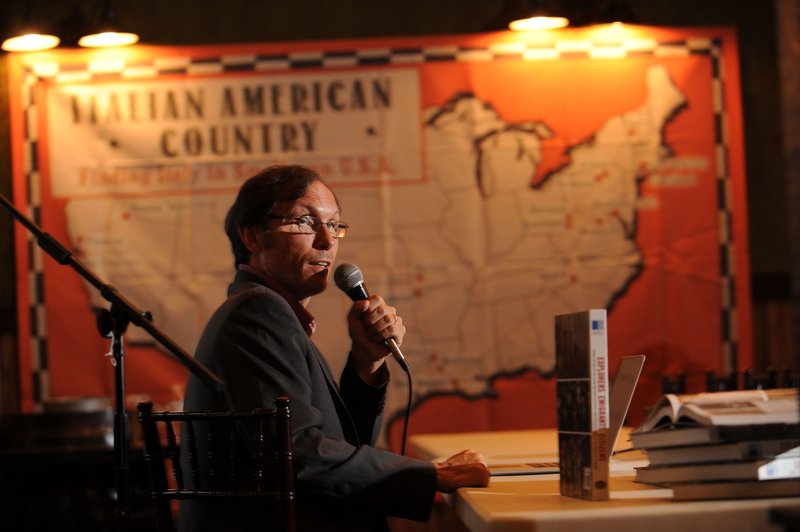The trip: 5,500 miles, 25 states, 35 days. Three Italian reporters set off across the United States to find Italy in Small Town, America. They stopped last week in Tontitown.
Paolo Battaglia addressed residents of Tontitown on Oct. 15 at the Willie James Event Center, at an event sponsored by the Tontitown Historical Museum. He spoke about his book, "Explorers, Emigrants, Citizens: A Visual History of the Italian American Experience," co-published by the Library of Congress (Anniversary Books, 2013).
Fast Facts
‘Explorers, Emigrants, Citizens’
Authors: Paolo Battaglia, Library of Congress
Publisher: Anniversary Books
Cost: $43.87 (Amazon)
Information: igg.me/at/itamcountry
The book includes more than 500 pictures of Italian Americans from the Library of Congress' collections, including one from Tontitown never seen in the community before. The photo -- on page 159 -- shows three women making spaghetti. The caption reads "1930s: In the small rural town of Tontitown, Arkansas, the grape season is celebrated with spaghetti."
Bev Cortiana-McEwen, treasurer of the museum board, said the photograph made its rounds via email through the Tontitown community before Battaglia arrived, and two of the women were identified -- Zelinda Bastianelli and Angela Lazzari -- and consensus said the chore was for the annual Grape Festival.
Finding America
The Italian title of the book, "Trovare l'America," translated means "Finding America." "I wanted to honor the people who came from Italy to the U.S. and fulfilled their dreams," Battaglia said. "It was my dream to work with the Library of Congress."
The first picture in the book features the Jefferson Building (main building) of the library, a beautiful setting mostly built by Italians from Tuscany renowned for their marble cutting, he said.
"When America needed to make a new monument, they brought over Italian craftspeople," Battaglia said. "The Italians also built roads and railroads. They were important to this country."
His book, co-authored by Linda Barrett Osborne, Mario Mignoni and Antonio Canovi, addresses Italian Americans from the explorer Christopher Columbus to Henri de Tonti, the Italian who helped René-Robert Cavelier, Sieur de La Salle, explore the Mississippi River and later founded Arkansas Post in 1686. It includes the earliest-known map (1536) to use the name "America." "(This country) was named by Italians," he pointed out.
Although most emigrants were farmers in Italy, their journeys brought them to large U.S. cities with factory work, Battaglia explained. And during World War II, many Italian-Americans chose to fight for their new home, with Italy as their enemy. They built planes that bombed Italy, including Battaglia's home town.
"Luckily, there was only one fallen soldier from Tontitown, and he was killed in Italy, trying to free his old country," Battaglia said. "(The Italians chose their loyalties) because what they had received from America was probably stronger than what they received from Italy."
He continued with contributions made by Italians in the worlds of sports, art, music and cinema.
But as Battaglia poured through the Library of Congress collection, he found few photos of emigrant Italian families living anywhere but large cities.
"If felt like there was something missing," Battaglia said. "I wondered what life was like for Italians outside of the large cities." And those feelings prompted this coast-to-coast tour.
Musings
Battalia's research introduced him to Tontitown, founded in 1898 by a group of Italian Catholic immigrants led by their priest, Father Pietro Bandini. Enticed to visit, he and his fellow reporters are chronicling what they see on the tour. "I want to speak with you, see the images you brought over or made here," he told the people of Tontitown. Information and photos gathered will be featured in a 2015 book and documentary.
Later, Battaglia shared several things he learned about Tontitown on his visit.
Although a few people in Tontitown can still speak Italian, those who do speak the dialect of the region from which their families came, he said. "In Italy until the mid-19th century, the country was divided in many independent states," Battaglia explained via email. "Inside each state, people spoke many different dialects -- actually very different one from the other. So, it is very striking for us, meeting some people who can speak the Veneto dialect from 100 years ago in a small Arkansas town."
Battaglia touted the Ranalli family, who are trying to revive the wine-making tradition of Tontitown through their Tontitown Winery. "We perceived that vineyards have been a founding stone of the town, and it is great to see the passion that young people are putting in keeping alive this aspect of Italian culture," Battaglia said.
"We also learned about the importance of women in establishing and strengthening the Italian colony of Tontitown," he continued. For many years, the men traveled as far as Oklahoma or Texas to work in mines and plants to supplement what money they could get from their farms. "And when the men were away, it was the women who took care of the farms and of the family," Battaglia said.
"At last, we cannot forget to mention Father Bandini: Almost a century has gone by since he died, but every one of the people we met had to say something about his importance, his leadership and the many things he did to help Tontitown and its people prosper," Battaglia concluded.
NAN Life on 10/22/2014
